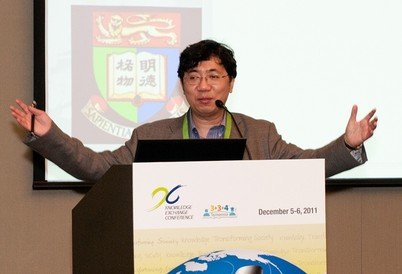Lighting the Way to Discovery
How does an idea get translated from the lab to the community? This is an eternal question in knowledge exchange. Professor C M Che, Dr Hui Wai Haan Chair of Chemistry and one of the top chemists in the world, has learned the answers the hard way.
How does an idea get translated from the lab to the community? This is an eternal question in knowledge exchange. Professor C M Che, Dr Hui Wai Haan Chair of Chemistry and one of the top chemists in the world, has learned the answers the hard way.
Professor Che, who has been doing research at HKU since 1983, is a world leading authority to develop innovative phosphorescent metal-organic compounds, paving the way for the development of light-emitting materials and other related applications. However, he did not do much applied studies and even not patent his original work before year 2000, leaving others to profit from it. ''At the time I didn't think it was important to my career,'' he says, as he preferred to focus on his laboratory work.
His views began to change in 1998, though, when he was asked what contribution he had made to society. He thought deeply on the question and realised he needed to do more to convince people of the value of chemistry. The best way to do that was to apply his findings.
An opportunity soon arose when a company approached Professor Che about sponsoring his research and developing his discoveries into useful products. By then he knew that he needed to start patenting his inventions to make them attractive to industries to invest.
He also needed some expertise in devising products that could maximize the potential of his discoveries. A postgraduate student from City University of Hong Kong, who specialised in physics and engineering and perfectly complemented his own strengths, was recruited.
They secured enough funding - most of it from industry - for a $10-million facility that enabled them to develop novel materials with practical applications in organic light-emitting diodes (OLEDs). OLEDs with unique features including fast response time, ultra-thin panel structure, low-power consumption and wide viewing angle, continue to draw substantial attention in the development of next generation of new display technology. Multinational chemical firms have since shown keen interest in Professor Che's research, although he is careful not to restrict opportunities for Hong Kong and China to benefit from his work.
''Through partnerships with local, international and Mainland display companies, we are working to promote the development of new lighting industry and innovative electronic consumer products in Hong Kong and South China in the coming decade,'' Professor Che says.
All of these experiences have led Professor Che, who is also the first Hong Kong recipient of the First Class Prize of China's State Natural Science Award, to conclude there are two important lessons in knowledge exchange. One is to keep learning. ''Even though at first I didn't have everything I needed to turn my innovations into useful products, I started to learn,'' he says.
The second message is to reach out to others. ''You need to talk to people, businesses, technology transfer colleagues, and students. I couldn't do this all by myself.''


